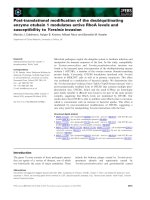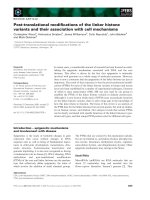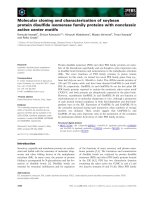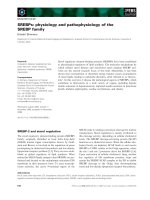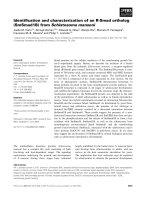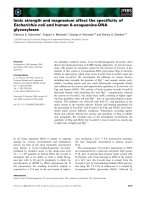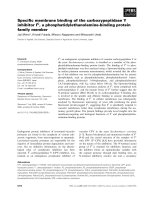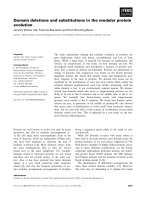Tài liệu Báo cáo Y học: Phosphatidylinositol synthesis and exchange of the inositol head are catalysed by the single phosphatidylinositol synthase 1 from Arabidopsis docx
Bạn đang xem bản rút gọn của tài liệu. Xem và tải ngay bản đầy đủ của tài liệu tại đây (245.28 KB, 6 trang )
Phosphatidylinositol synthesis and exchange of the inositol head
are catalysed by the single phosphatidylinositol synthase 1
from
Arabidopsis
Anne-Marie Justin, Jean-Claude Kader and Sylvie Collin
Universite
´
Pierre et Marie Curie and CNRS, Laboratoire de Physiologie Cellulaire et Mole
´
culaire, Paris, France
In order to study some of its enzymatic properties,
phosphatidylinositol synthase 1 (AtPIS1) from the plant
Arabidopsis thaliana was expressed in Escherichia coli, a host
naturally devoid of phosphatidylinositol (PtdIns). In the
context of the bacterial membrane and in addition to de novo
synthesis, the plant enzyme is capable of catalysing the
exchange of the inositol polar head for another inositol. Our
data clearly show that the CDP-diacylglycerol-independent
exchange reaction can occur using endogenous PtdIns
molecular species or PtdIns molecular species from soybean
added exogenously. Exchange has been observed in the
absence of cytidine monophosphate (CMP), but is greatly
enhanced in the presence of 4 l
M
CMP. Our data also show
that AtPIS1 catalyses the removal of the polar head in the
presence of much higher concentrations of CMP, in a
manner that suggests a reverse of synthesis. All of the PtdIns
metabolizing activities require free manganese ions. EDTA,
in the presence of low Mn
2+
concentrations, also has an
enhancing effect.
Keywords: Arabidopsis; exchange reaction; phosphatidy-
linositol; phospholipid synthesis; reverse reaction; synthase.
Phosphatidylinositol (PtdIns) labelling has long been
known to occur via two possible mechanisms: a de novo
synthesis, catalysed by phosphatidylinositol synthase (EC
2.7.8.11), also known as CDP-diacylglycerol (DAG)/myo-
inositol 3-phosphatidyltransferase, and an exchange reac-
tion whereby the sugar head is exchanged between
pre-existing PtdIns molecules and free inositol, leading in
a test tube and in the absence of CDP-diacylglycerol (CDP-
DAG) to the synthesis of labelled PtdIns when radioactive
inositol is used [1]. In animal [2–6] as well as in plant tissues
[7,8] and in the green algae Chlamydomonas reinhardtii [9],
this exchange reaction has been associated to the endoplas-
mic reticulum (ER) or to microsomal fractions rich in ER,
where de novo synthesis of PtdIns is most active. Thorough
enzymatic characterization of synthesis and exchange has
attemptedtounderstandifbothreactionsaremediatedby
the same enzyme, but only one study has shown that one
gene product, phosphatidylinositol synthase from the yeast
Saccharomyces cerevisiae, carries both activities [10].
In plants, for 20 years, the lack of cloned sequences had
prevented the investigations necessary to determine whether
the situation is the same as in yeast; however, the cloning
and expression of a cDNA encoding PtdIns synthase in
Arabidopsis thaliana [11] has enabled us to do so. The results
presented here clearly show that AtPIS1 is able, when
expressed in a bacterial system, to catalyse both de novo
synthesis of PtdIns as well as exchange of the inositol polar
head. In addition, we also suggest that placed in the
appropriate conditions, the enzyme is able to catalyse the
reaction reverse of synthesis. The substrates for exchange
can be PtdIns molecular species made by the enzyme or
exogenous molecular species differing in their fatty acid
content. The presence of a chelating agent of manganese,
which is indispensable for de novo synthesis and exchange
activities [1,6,11], had the same effect on both, suggesting
that the enzymatic active site used could be the same in both
cases.
MATERIALS AND METHODS
Genetic nomenclature
The cDNA used in this work corresponds to EMBL
accession number H36646 [11] and gene AtPIS1.
Growth conditions of the bacterial transformants
Escherichia coli cells expressing the AtPIS1 cDNA enco-
ding phosphatidylinositol synthase 1 from Arabidopsis
thaliana (AtPIS1) were obtained in the same way and are
the same as those described [11]. Two bacterial strains were
used, one expressing the plant cDNA (previously called
strain 2, now called strain +PIS), and the nonexpressing
control strain (previously called strain 3a and now called
strain –PIS). The cells were grown at 37 °CinLuria–
Bertani medium (Miller, Difco) supplemented with 1 m
M
myo-inositol and 100 lgÆmL
)1
ampicillin. In the case of
Correspondence to S. Collin, Universite
´
Pierre et Marie Curie,
Laboratoire de Physiologie Cellulaire et Mole
´
culaire, UMR 7632
CNRS, Paris 6, Tour 53, 4
e
tage, Case Courrier 154, 4, Place Jussieu,
75252 Paris Cedex 05, France.
Fax: + 33 1 44 27 61 51, Tel.: + 33 1 44 27 59 13,
E-mail:
Abbreviations: PtdIns, phosphatidylinositol; PtdOH, phosphatidic
acid; CDP-DAG, CDP-diacylglycerol; CMP, cytidine
monophosphate; CTP, cytidine triphosphate.
Enzymes: phosphatidylinositol synthase or CDP-diacylglycerol/
myo-inositol 3-phosphatidyltransferase (EC 2.7.8.11).
(Received 4 October 2001, revised 13 March 2002,
accepted 20 March 2002)
Eur. J. Biochem. 269, 2347–2352 (2002) Ó FEBS 2002 doi:10.1046/j.1432-1033.2002.02893.x
experiments requiring bacterial membranes devoid of
PtdIns, the cells were grown in M9 minimal medium [12]
supplemented with 2 gÆL
)1
vitamin-free casein (Sigma) and
100 lgÆmL
)1
ampicillin. The water used was ultrapure,
filtered on a Millipak Filter Unit 0.22 lm rated (Millipore).
Expression of the cDNA was induced in fresh transform-
ants as described previously [11] before the cells were
washed in 50 m
M
Tris/HCl pH 8.0 and stored as pellets at
)80 °C. These pellets were used for lipid analyses or as a
source of membrane proteins.
Enzymatic activities
Membrane purifications were carried out at 5 °C. E. coli
cells were resuspended at a density of 100 lg fresh
cellsÆmL
)1
in sonication buffer containing 50 m
M
Tris/
HCl pH 8.0, 8% (v/v) glycerol and 8 m
M
2-mercaptoeth-
anol. After sonication, intact cells were eliminated by
centrifugation at 4500 g for 10 min and washed once in
sonication buffer. The two supernatants were pooled and
centrifuged at 100 000 g for 1 h. The membrane pellet was
resuspended in 20 m
M
Tris/HCl pH 8.0, 20% (v/v) glycerol,
8m
M
2-mercaptoethanol, aliquoted and stored at )80 °C.
The protein concentration was determined according
to Lowry et al. [13] using BSA as standard.
De novo synthesis. Unless stated otherwise, the incubation
conditions for de novo PtdIns synthase activity were 50 m
M
Tris/HCl pH 8.0, 0.3 m
M
CDP-DAG dipalmitoyl (Sigma),
2.4 m
M
Triton X-100, 0.5 m
M
myo-inositol (Amersham,
[
3
H]-labelled, diluted with unlabelled myo-inositol to a final
activity of 500 BqÆnmol
)1
), 2.5 m
M
MnCl
2
and 10–50 lg
membrane proteins. Samples were incubated in a final
volume of 200 lLat30°C for 20 min The reaction was
stopped on ice by the addition of 3 mL ice-cold methanol/
chloroform (2 : 1). Lipids were then extracted according to
Sambrook et al. [12]. The chloroform phase was washed
with methanol and 1% (w/v) sodium chloride in the
proportion 1 : 1 : 1. Radioactivity was measured on a
100-lL aliquot mixed with 6 mL of Emulsifier Safe
TM
(Packard) using a scintillation counter.
Exchange reaction. The exchange reaction was assayed by
incubating 50–200 lg membrane proteins in 50 m
M
Tris/
HCl pH 8.0, 0.36 m
M
PtdIns from soybean (Sigma),
0.5 m
M
myo-inositol containing tritium-labelled myo-inos-
itol for a final activity of 500 BqÆnmol
)1
,2.4m
M
Triton
X100, 2.5 m
M
MnCl
2
in the presence or in the absence of
4 l
M
cytidine monophosphate (CMP), but without CDP-
DAG. The incubation time at 30 °C was 20–30 min.
CMP-dependent PtdIns hydrolysis. This reaction was
followed by incubating 50–200 lg membrane proteins in
50 m
M
Tris/HCl pH 8.0, 3 m
M
CMP, 2.4 m
M
Triton X100,
2.5 m
M
MnCl
2
and 42 l
M
PtdIns [soybean PtdIns from
Sigma diluted with [myo-inositol-2-
3
H(N)] PtdIns, (NEN)
to a final activity of 240 BqÆnmol
)1
]at30°C for 20–40 min.
After extraction of total lipids as described above, the
reverse activity was measured on the lower phase after
concentration under nitrogen and mixing with 6 mL
Emulsifier Safe
TM
or on the upper phase washed with
chloroform (2 : 1), concentrated and mixed with 12 mL
Emulsifier Safe
TM
.
Effect of EDTA on enzymatic reactions
All buffers and aqueous solutions were prepared in distilled
water (Autostill
TM
Autofour, Jencons). To the incubation
medium containing the above-mentioned concentrations of
Tris/HCl pH 8.0, Triton X100, MnCl
2
and EDTA were
added the appropriate missing components according to the
reaction studied. Each reaction was started by the addition
of membrane proteins.
Labelling of endogenous PtdIns molecular species
Microsomes from germinating soybean (Glycine max L.
cv. Weber) plantlets were prepared from 5 g seeds as
described [14]. They were resuspended in the same buffer
as E. coli membranes and stored at )80 °C. Membranes
(1.5 mg membrane proteins for E. coli, 3 mg membrane
proteins for soybean microsomes) were incubated in
50 m
M
Tris/HCl pH 8.0, 2.4 m
M
Triton X100, 5 m
M
EDTA, 0.1 m
M
cytidine triphosphate (CTP), 7.5 m
M
MnCl
2
and 2-
3
H(N)-myo-inositol (NEN, 0.46 MBq,
85 · 10
4
MBqÆmmol
)1
) in a final volume of 1.6 mL for
30 min at 30 °C. The reaction was stopped by the
addition of 4.8 mL methanol/chloroform (2 : 1) as before
and lipids were extracted.
3
H-Labelled PtdIns molecular
species were identified by radio-HPLC.
Analysis of radioactive PtdIns molecular species
After separation by TLC according to Lepage [15], the
PtdIns spot was scrapped and PtdIns eluted at 8 °C
overnight from the silica in 5 mL methanol containing
one drop of glacial acetic acid. After re-extraction of the
sample according to Bligh & Dyer [16], PtdIns molecular
species were analysed by radio-HPLC as described previ-
ously [17].
RESULTS
Enzymatic activities catalysed by AtPIS1
Previously published results indicate that the yeast PtdIns
synthase placed in a microbial environment is capable of
catalysing several enzymatic reactions: PtdIns de novo
synthesis, using CDP-DAG and free inositol as substrates
and producing PtdIns and CMP; a CMP-independent
exchange reaction whereby the inositol molecule of PtdIns
can be replaced by another inositol polar head without
net synthesis of PtdIns; a CMP-dependent exchange
reaction, far greater in quantitative terms than the
CMP-independent one; and, finally, a reaction which is
the reverse of synthesis, dependent on higher concentra-
tions of CMP [10]. As the exchange reaction has also been
suggested to occur in plants [7,8], we tested it using
isolated bacterial membranes as a source of enzyme. The
transformation of E. coli, a host naturally devoid of
PtdIns synthase with a single cDNA ensured that the
recombinant protein was the only candidate for the
activities tested.
E. coli cells expressing the AtPIS1 cDNA were cultivated
on M9 minimal medium supplemented with vitamin-free
amino acids to allow isolation of bacterial membranes
lacking endogenous PtdIns, which would interfere with
2348 A M. Justin et al. (Eur. J. Biochem. 269) Ó FEBS 2002
exogenous PtdIns. De novo synthesis was measured in the
incubation conditions described above, in the presence of
CDP-DAG and myo-inositol (Table 1).
The exchange reaction was assayed by incubating
bacterial membranes with
3
H-labelled free myo-inositol
and cold soybean PtdIns, no exogenous CDP-DAG, in
the presence or absence of 4 l
M
CMP. The PtdIns
concentration used was 0.36 m
M
as in Klezovitch et al.
[10]. At the end of the incubation period total lipids were
extracted and the amount of labelled PtdIns was
determined (Table 1). In the absence of CMP, the
presence of AtPIS1 allows the incorporation of labelled
inositol into PtdIns, according to the enzymatic reaction
called exchange. This reaction is greatly enhanced by the
presence of 4 l
M
CMP, about ninefold under our
conditions.
The assay for a reverse reaction was carried out by
measuring the CMP-dependent release of label from
3
H-PtdIns in the aqueous phase of total lipid extractions
as in Bligh & Dyer [16]. Radioactivity was measured in
the lower chloroform and upper aqueous phases. In the
absence of CMP and in both +PIS and –PIS strains, a
release of label in the aqueous phase was observed after
incubation. To calculate the liberation of radioactivity
due to a putative reverse reaction, the amount of label
released in the absence of CMP was substracted from that
released in the presence of 3 m
M
CMP (Table 1). Mem-
brane samples containing PtdIns synthase catalyse the
liberation of label in the upper phase (which would
correspond to 130 pmol inositolÆmin
)1
Æmg
)1
), counterbal-
anced by an equivalent disappearance of PtdIns in the lower
phase ()108 pmolÆmin
)1
Æmg
)1
). On the other hand, mem-
branes lacking AtPIS1 do not induce any variation in the
radioactivity partitioned between each phase during the
incubation time, indicating that the appearance of
3
H-label
in the upper phase is specific to AtPIS1. Several 5¢-CMP
concentrations ranging between 0 and 6 m
M
were tested to
assess the CMP dependence of PtdIns hydrolysis. The
results (data not shown) do indicate that this is the case.
Nevertheless, the appearance of CDP-DAGs could not be
detected (data not shown). This protein-specific release and
CMP-dependent release of label from PtdIns could be
explained by a reaction which is the reverse of synthesis.
The exchange reaction studied by analysis
of radioactive PtdIns molecular species
The exchange reaction was also studied by analysis of the
radiolabelled PtdIns molecular species produced using
various PtdIns substrates (Fig. 1). This experiment is based
on the fact that the Ptdns molecular species synthesized in
E. coli from endogenous CDP-DAG are very different from
those found in plants, in particular soybean, whose PtdIns
composition has been described previously [14]. PtdIns
species made from endogenous CDP-DAG were first
Table 1. Enzymatic reactions catalysed by AtPIS1 expressed in E. coli.
Transformant E. coli were cultivated on a medium lacking inositol,
membranes were purified as described in Materials and methods and
incubated under various conditions with different substrates. The
values indicated and in pmol PtdInsÆmin
)1
Æmg
)1
protein. In the upper
phase they are given as pmol inositolÆmin
)1
Æmg
)1
.Eachvalueisthe
mean ± SD of four (+PIS) or three (–PIS) experimental points using
the same protein sample. Enzymatic reactions carried out with mem-
branes isolated from different cultures of transformant E. coli cells
gave very similar results. Conditions for: reverse reaction,
+
3
H-PtdIns + 3 m
M
CMP; exchange reaction, +
3
H-Ins + 0.36 m
M
PtdIns.
+PIS –PIS
+ CDP-DAG
De novo synthesis 2019 ± 71 0
– CDP-DAG
Reverse reaction
Lower phase )108 ± 5 )1
Upper phase 103 ± 13 0
Exchange reaction
– CMP 125 ± 5 0
+4l
M
CMP 1109 ± 138 0
Fig. 1. Radio-HPLC separation of PtdIns molecular species synthes-
ized: (A) by AtPIS1 present in E. coli membranes incubated with CTP
and myo-inositol, but no exogenous CDP-DAGs; (B) by germinating
soybean microsomes, under the same substrate conditions as in (A);
(C) in exchange conditions in the presence of 4 l
M
CMP and soybean
PtdIns by membranes from E. coli +PIS grown on a medium
supplemented with myo-inositol or (D) lacking myo-inositol. The
incubation conditions are as described in Materials and methods.
Ó FEBS 2002 Arabidopsis phosphatidylinositol synthase 1 (Eur. J. Biochem. 269) 2349
studied by incubating membranes from E. coli +PIS
cultivated on medium lacking inositol or microsomes from
germinating soybean in the presence of CTP and
3
H-labelled inositol as in Justin et al. [14]. No exogenous
CDP-DAG was added so that PtdIns could only arise from
an endogenous production following the reactions: phos-
phatidic acid (PtdOH) + CTP fi CDP-DAG + PPi
(pyrophosphate) followed by CDP-DAG +
3
H-inosi-
tol fi
3
H-PtdIns + CMP. PtdIns molecular species were
then separated by radio-HPLC. In E. coli (Fig. 1A), C14:0/
C16:0 PtdIns elutes almost at the same time as the C16:0/
C18:3 molecular species in soybean (Fig. 1B), but other
molecular species are eluted at times which allow a perfect
distinction between the two sets of PtdIns molecules: the
C16:0/C17c + C18:1/C17c and C16:0/C19c peaks are
characteristic of E. coli (A M. Justin, unpublished data)
whereas the C16:0/C18:2 and C18:0/C18:2 PtdIns are
characteristic of soybean [14].
In a second experiment, membranes isolated from
E. coli + PIS grown on Luria–Bertani medium and inos-
itol (Fig. 1C) or M9 medium lacking inositol (Fig. 1D)
were incubated in conditions of exchange in the presence of
PtdIns isolated from soybean. The radio-HPLC elution
profile of PtdIns shows that when endogenous PtdIns is
present in the bacterial membrane, molecular species
typical of E. coli and others of soybean become labelled
(Fig. 1C). The bacterial membrane contains endogenous
PtdIns that could be used as a substrate for exchange of the
inositol head but also endogenous CDP-DAG molecules
which can be used for de novo synthesis of PtdIns.
Nevertheless, when bacterial membranes lacking endo-
genous PtdIns were incubated in the same exchange
conditions, the only labelled PtdIns molecular species
detected were of soybean origin (Fig. 1D), showing: (a)
that exogenous soybean PtdIns is used for exchange; (b)
that the endogenous bacterial CDP-DAGs are not present
in sufficient amount to give rise to detectable de novo
synthesized PtdIns molecular species. In Fig. 1C, the
labelled PtdIns of bacterial origin therefore arises from
an exchange reaction.
Effect of EDTA on the enzymatic activities
of PtdIns synthase
The net activity of PtdIns synthase as an exchange enzyme
stimulated by low concentrations of CMP is far from being
negligible when compared to de novo synthesis (Table 1).
For evaluation of net synthesis, one might wish to inhibit
the exchange and one laboratory reported, to this end, that
the addition of 5 m
M
EDTA was sufficient to abolish the
exchange ability of PtdIns synthase when incubated in
conditions of de novo synthesis [8]. In our own experiments,
we have observed that adding 5 m
M
EDTA leads to an
enhancement of inositol incorporation provided that the
concentration of manganese is correspondingly increased to
7.5 m
M
to compensate the chelating effect of EDTA
(unpublished results). We therefore investigated the effect
of EDTA on the reactions catalysed by PtdIns synthase in
the presence of 7.5 m
M
MnCl
2
. The results are shown in
Fig. 2A and B.
At 0 m
M
EDTA, i.e., 7.5 m
M
MnCl
2
, de novo synthesis
reached 0.83 nmol PtdInsÆmg
)1
Æmin
)1
(Fig. 2A). As the
EDTA concentration increased, synthesis increased up to
a maximum activity of 2.0 nmol PtdInsÆmg
)1
Æmin
)1
between 2.5 and 5 m
M
EDTA. At 10 m
M
,synthesis
decreased to 0. In the conditions used here we detected
two exchange activities, one stimulated by CMP and one
independent of CMP. The CMP-dependent activity showed
an incorporation profile of labelled inositol that closely
paralleled that of the de novo synthesis activity (Fig. 2A),
with values close to 0.8 nmol PtdInsÆmg
)1
Æmin
)1
at 0 m
M
EDTA, increasing to 2 nmol PtdInsÆmg
)1
Æmin
)1
between
2.5 and 5 m
M
EDTA and a drop to 0 at 10 m
M
.
Abolition of all exchange activity at 10 m
M
EDTA shows
that the process requires manganese ions. On the other
hand, the CMP-independent activity was much lower,
with a value close to 0.15 nmol PtdInsÆmg
)1
Æmin
)1
at 0 m
M
EDTA which peaked
1
at 0.35 nmol PtdInsÆmg
)1
Æmin
)1
between 2.5 and 5 m
M
. Comparatively, the CMP-depend-
ent PtdIns hydrolysing activity was the lowest of all in our
conditions.
To evaluate better the effect of the chelator on each
reaction, each activity was normalized to that obtained at
5m
M
EDTA and plotted as a function of the free Mn
2+
concentration (Fig. 2B). The data show that synthesis and
exchange with or without CMP behave in the same way
according to the concentration in available Mn
2+
.
Fig. 2. Effect of EDTA on the enzymatic reactions catalysed by PtdIns
synthase. The results shown here are typical of those observed for at
least two independent cultures. (A) All activities were measured in the
presence of 7.5 m
M
MnCl
2
. Fifty lg microsomal proteins were incu-
batedfor20minasdescribedinMethods.d, De novo synthesis; j,
exchange reaction in the presence of 4 l
M
CMP; h, exchange reaction
with no CMP added; m, CMP-dependent PtdIns hydrolysis. (B)
De novo synthesis (light grey), exchange activities (–CMP, striped bar;
+CMP, medium grey) and CMP-dependent PtdIns hydrolysis (dark
grey) normalized to their respective values obtained at 5 m
M
EDTA,
plotted as a function of EDTA concentration in the medium. (C)
Comparison of de novo synthesis activities obtained with different
concentrations of EDTA at constant manganese concentrations:
7.5 m
M
(d)or2.5m
M
(s). (D) Comparison of de novo synthesis
activities as a function of the calculated free Mn
2+
concentration
available in the medium at 7.5 m
M
MnCl
2
and different concentrations
of EDTA (black circles), 2.5 m
M
MnCl
2
and various amounts of
EDTA (s)ordifferentconcentrationsofMnCl
2
[11] (m). At 0 m
M
Mn
2+
, all enzyme activities are null. Because of the x axis chosen,
activities obtained at submicromolar Mn
2+
concentrations in the
experiments involving fixed concentrations of manganese chloride and
varying amounts of EDTA appear on the y axis just above 0.
2350 A M. Justin et al. (Eur. J. Biochem. 269) Ó FEBS 2002
Effect of EDTA as a function of the concentration
in free manganese ions
Theconcentrationoffreemanganeseionswascalculatedat
each EDTA concentration using an apparent EDTA
stability constant K
1
of 5 · 10
11
Æ
M
)1
for manganese at
pH 8.0
[18]. At 7.5 m
M
EDTA, when the calculated con-
centration of free manganese ions is in the submicromolar
range, a synthesis activity of 1.53 nmol PtdInsÆmg
)1
Æmin
)1
could still be measured (Fig. 2C). When this activity was
tested at a lower MnCl
2
concentration with various amounts
of EDTA, the highest activity was not observed at 0 m
M
EDTA and 2.5 m
M
MnCl
2
as seen before [11], but at 2.5 m
M
EDTAwhentheconcentrationinfreemanganeseionsis
close to 0.1 l
M
. An alignment on the same plot of the values
found for de novo synthesis in the presence of 7.5 or 2.5 m
M
MnCl
2
with various amounts of EDTA, or in the presence of
MnCl
2
only [11], as a function of the concentration in free
manganese (Fig. 2D), shows that in the presence of EDTA
concentrations < 2.5 m
M
free Mn
2+
give higher activities
than those observed with Mn
2+
alone, suggesting an
activating effect of EDTA on enzymatic activity.
DISCUSSION
The exchange reaction
Using the same incubation conditions for PtdIns and CMP
as those published by Klezovitch et al. [10] for examination
of the PtdIns synthase from yeast expressed in a bacterial
system, we found that the Arabidopsis enzyme expressed in
E. coli is able to catalyse not only de novo synthesis of
PtdIns but also the exchange reactions in the absence or in
the presence of CMP. In plants, the exchange reaction is
known to occur [7,8] but it has never been shown to be
catalysed by the same enzyme as that responsible for de novo
synthesis. The experimental conditions used reproduce the
parameters defined as optimum by Sexton & Moore [7] and
Sandelius & Morre
´
[8] with a pH of 8.0 and the presence of
manganese ions. In the range of concentrations tested, we
found an optimum free manganese ion concentration of
2.5 m
M
, a value that is in the same range as the concen-
trations found by the authors cited above.
In a preliminary work (data not shown), we have
observed that when E. coli membranes prepared from cells
grown in inositol-containing medium are incubated with
labelled inositol but no CDP-DAG and no PtdIns, no
labelled PtdIns appears, showing that the endogenous level
of CDP-DAG is too low to allow detectable synthesis. The
level of PtdIns in the membranes does not allow synthesis of
detectable PtdIns by exchange of the polar head. As in
Fig. 1D the only source of PtdIns molecular species
characteristic of E. coli that we detect can only come from
the bacterial membrane, we explain this result by a global
stimulation of the exchange reaction by the exogenous
soybean PtdIns.
A question that arises is the relevance of the exchange
of polar head when de novo synthesis is studied. We
calculated that with a linear rate of synthesis of 2 nmol
PtdInsÆmin
)1
Æmg
)1
(Fig. 2), the concentration of CMP in a
reaction mixture of 200 lLis4l
M
after 1 min. with 50 lg
protein. As our incubation conditions use 50 lg protein
incubated for 20 min, although the corresponding PtdIns
concentration does not reach the value used to study
exchange, it is possible that this latter reaction takes place,
possibly interfering with the net de novo synthesis capacity
of PtdIns synthase, especially if the membranes used as a
source of enzyme are rich in PtdIns.
Another question is the reason why CMP stimulates the
exchange reaction and what the exact mechanism for
exchange is. Our data does not allow us to distinguish
between a reverse reaction followed by re-synthesis, as
suggested by Paulus & Kennedy [19], and a real exchange.
The fact that EDTA has the same effect, in particular
a stimulation between 2.5 and 5 m
M
, on all reactions
catalysed by PtdIns synthase seems to suggest that the
chemical reactions involved are not very different, but that
the enzymatic parameters in favour of synthesis, reverse
reaction or exchange are quite different in terms of
concentrations of the reactants in each case; a simple
reverse reaction followed by synthesis is puzzling or in any
case very difficult to analyse in terms of kinetics. From a
functional point of view, if a reaction reverse of synthesis
followed by synthesis using CDP-DAGs different from
those liberated was responsible for the exchange activity we
detected, it could be a mechanism whereby in defined
conditions cells could specifically destroy particular PtdIns
molecular species to replace them by others more adapted to
new physiological or environmental parameters.
Removal of the polar head
The data presented here are not an absolute proof that
PtdIns synthase catalyses a true reverse reaction. The
enzymatic activity we detected is nevertheless strictly
dependent on CMP, and strictly associated with the AtPIS1
protein. The dependence of the PtdIns synthase reverse
reaction has been extensively studied in rat pituitary GH3
cells, where the authors have identified the reverse products
and shown that the CMP activation of the reverse of
synthesis is by a different mechanism from base exchange
[20]. Further analysis of the products released from PtdIns
by the Arabidopsis enzyme will allow us to carry out a
deeper study of this particular activity of the protein.
Effect of EDTA on PtdIns synthase reactions
Our data show that at free manganase ion concentrations
far lower than those found to be the optimum when
manganese is used on its own, there are still de novo
synthesis and exchange reactions the activities of which are
close to those seen when no chelating agent is used. This
effect has been studied particularly in the case of de novo
synthesis, where a comparison between data presented here
and data published previously by us clearly show that
EDTA enhances the activity. The pH remained unchanged
between each condition of the EDTA plot, which rules out a
simple pH effect to explain the variations in enzymatic
activity. One possibility therefore is that EDTA could
chelate inhibitory ions, whose identity remains unclear,
maybe with a higher affinity than for Mn
2+
.
If it is clear, for the first time, that a PtdIns synthase from
Arabidopsis is able to catalyse both de novo synthesis of
PtdIns and the exchange of the inositol moiety, but it is still
uncertain by what mechanism this exchange is carried out.
In terms of kinetics, the enzymatic conditions used do not
Ó FEBS 2002 Arabidopsis phosphatidylinositol synthase 1 (Eur. J. Biochem. 269) 2351
favour a reverse reaction followed by re-synthesis. Never-
theless, EDTA seems to have the same effect on both
synthesis and exchange, so further characterization of each
activity is needed to see whether PtdIns synthase uses two
different active sites, as made possible by the existence of
two hydrophilic pockets in the protein [11], whether the
same active site can adopt different conformations accord-
ing to substrate concentrations or physico-chemical condi-
tions or, finally, whether exchange is, mechanistically, an
inverse synthesis followed by re-synthesis. The work carried
out on the rabbit lung and rat liver microsomal enzyme
seemed to suggest different enzymes as the pH and divalent
cation requirements were different for the two activities
[4,21] but their results could perhaps be explained by two
different catalytic sites. Sexton & Moore also suggested for
the castor bean endosperm enzyme that exchange is not a
reversal of the transferase activity [7]. No obvious sequence
similarities with other proteins catalysing an exchange of
phospholipid head, such as phosphatidylserine synthase
(CMP-PtdOH/
L
-serine 3-phosphatidyltransferase), came up
when alignments were made (data not shown) so the
question remains open until further data, currently being
compiled in our laboratory, are obtained, with the aim of
understanding how PtdIns synthase functions and is
regulated.
ACKNOWLEDGEMENTS
The authors thank A. Zachowski, E. Ruelland and A. Jolliot-Croquin
for helpful discussions and advice. This project was funded by the
French Ministries of Research and Education via CNRS and the
University Pierre et Marie Curie (Unite
´
Mixte de Recherche 7632).
REFERENCES
1. Moore, T.S. (1990) Biosynthesis of phosphatidylinositol. In Inos-
itol Metabolism in Plants (Morre
´
, D.J., Boss, W.F. & Loewus,
F.A., eds), pp. 107–112. Wiley-Liss, New York.
2. Holub, B.J. (1974) The Mn
2+
-activated incorporation of inositol
into molecular species of phosphatidylinositol in rat liver micro-
somes. Biochim. Biophys. Acta 369, 111–122.
3. Takenawa, T. & Egawa, K. (1980) Phosphatidylinositol:myo-
inositol exchange enzyme from rat liver: partial purification and
characterization. Arch. Biochem. Biophys. 202, 601–607.
4. Bleadsdale, J.E. & Wallis, P. (1981) Phosphatidylinositol-inositol
exchange in rabbit lung. Biochim. Biophys. Acta 664, 428–440.
5. McPhee, F., Lowe, G., Vaziri, C. & Downes, C.P. (1991)
Phosphatidylinositol synthase and phosphatidylinositol/inositol
exchange reactions in turkey erythrocyte membranes. Biochem.
J. 275, 187–192.
6. Irvine, R.F. (1998) Manganese-stimulated phosphatidylinositol
headgroup exchange in rat liver microsomes. Biochim. Biophys.
Acta 1393, 292–298.
7. Sexton, J.C. & Moore, T.S. Jr (1981) Phosphatidylinositol
synthesis by a Mn
2+
-dependent exchange enzyme in castor bean
endosperm. Plant Physiol. 68, 18–22.
8. Sandelius, A.S. & Morre
´
, D.J. (1987) Characteristics of a phos-
phatidylinositol exchange activity of soybean microsomes. Plant
Physiol. 84, 1022–1027.
9. Moore, T.S. Jr & Blouin, A.M. (2001) Membrane lipid
biosynthesis in Chlamydomonas reinhardtii. Identification and
partial characterization of CDP-diacylglycerol: inositol transferase
and myo-inositol exchange reactions. Quadrennial Joint Meetings
of the American Society of Plant Biologists and the Canadian
Society of Plant Physiologists, Plant Biology, Providence, Rhode
Island, USA 21–25 July 2001. Poster, 460, 401–402.
10. Klezovitch, O., Brandenburger, Y., Geindre, M. & Deshusses, J.
(1993) Characterization of reactions catalysed by yeast phospha-
tidylinositol synthase. FEBS Lett. 320, 256–260.
11. Collin, S., Justin, A M., Cantrel, C., Arondel, V. & Kader, J C.
(1999) Identification of AtPIS, a phosphatidylinositol synthase
from Arabidopsis. Eur. J. Biochem. 262, 652–658.
12. Sambrook, J., Fritsch, E.F. & Maniatis, T. (1989) Molecular
Cloning: a Laboratory Manual, 2nd edn. Cold Spring. Harbor
Laboratory Press, Cold Spring Harbor, New York.
13. Lowry, O.H., Rosebrough, N.J., Farr, A.L. & Rendall, R.J. (1952)
Protein measurements with the Folin phenol reagent. J. Biol.
Chem. 193, 265–275.
14. Justin, A M., Demandre, C. & Mazliak, P. (1989) Molecular
species synthesized by phosphatidylinositol synthases from potato
tuber, pea leaf and soya bean. Biochim. Biophys. Acta 1005, 51–55.
15. Lepage, M. (1967) Identification and composition of turnip root
lipid. Lipids 2, 244–250.
16. Bligh, E.G. & Dyer, W.J. (1959) A rapid method for total lipid
extraction and purification. Can. J. Biochem. Physiol. 37, 911–917.
17. Justin, A M., Hmyene, A., Kader, J C. & Mazliak, P. (1994)
Compared selectivities of the phosphatidylinositol synthase from
maize coleoptiles either in microsomal membranes or after solu-
bilization. Biochim. Biophys. Acta 1255, 161–166.
18. Dawson, R.M.C., Elliot, D.C., Elliot, W.H. & Jones, K.M. (1969)
Data for Biochemical Research, 2nd edn, pp. 426–427. Oxford
University Press, Oxford.
19. Paulus, H. & Kennedy, E.P. (1960) J. Biol. Chem. 235, 1303–1311.
20. Cubitt, A.B. & Gershengorn, M.C. (1990) CMP activates
reversal of phosphatidylinositol synthase and base exchange by
distinct mechanisms in rat pituitary GH
3
cells. Biochem. J. 272,
813–816.
21. Takenawa, T., Saito, M., Nagai, Y. & Egawa, K. (1977) Solubi-
lization of the enzyme catalyzing CDP-DAG-independent
incorporation of myo-inositol into phosphatidylinositol and its
comparison to CDP-diglyceride: inositol transferase. Arch. Bio-
chem. Biophys. 182, 244–250.
2352 A M. Justin et al. (Eur. J. Biochem. 269) Ó FEBS 2002


